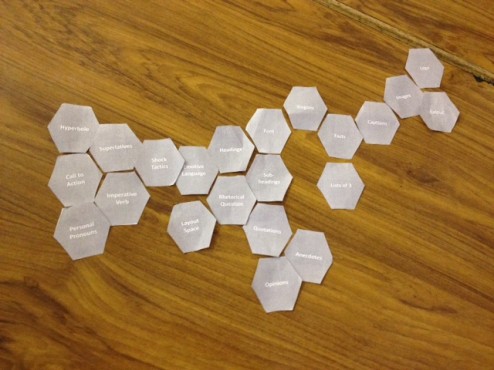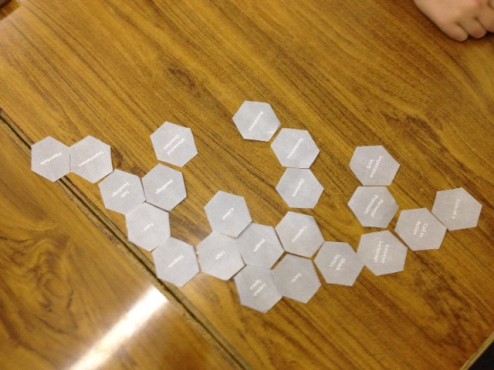I am not going to write a SOLO taxonomy thinking post, I do not know it well enough, I haven’t I explored it far enough nor taught with it in mind. But I will. However the hexagonal tessalating idea, now I am up for that. I may even combine it to shoeless teaching. There’s lots of other excellent uses for hexagonal learning. Tait Coles, Chris Harte and David Didau are already ahead of the game. These guys have put together a useful Prezi, share Teachmeet videos and shared class footage. The practitioners have already provide some very compelling evidence so perhaps I can help in a different way?
Here is a hexagonal learning template and four reflections from today’s lesson and a few more images.
- Group’s of 2 were productive, 3 seemed to be engage and discussing the hexagons, 4 seemed a little strained.
- The students wanted to ‘finish’ the task and they wanted to know if they had got it right. In the second lesson, I really emphasised that first they needed to decided on the hexagon associations. That there was no ‘right’ answer and that they would need to be able defend their solutions.
- The students did not see discussion and justifying the hexagon placement as learning.
- The best thinking came about when I challenged their hexagon placements.
Listen to my latest phonecast
You heard the student feedback, here is their work. I did keep the cut-out hexagons for next time. I think I will soon have a draw full of hex learning activities. Bring on the novels!



Great to see people latching on to hexagon methods.
We have been developing such tools and methods since the 70s.
We would be glad to help accelerate learning in this area.
Take a look at http://www.logovisual.com/knowledgebase.
Apart from various toolkits available from that website, there is a book, “Making Meaning – Learning through Logovisual Thinking” – which gives many examples.
Regards
John
There is much to be said for ‘handling’ the learning. We started with paper hexagons that I had labelled and I even shared the Powerpoint template. We (David Riley and I) then started work on an interactive version before road testing it with students. The journey of http://www.triptico.co.uk/thinklink.html was recorded here on the blog with many of the better ideas suggested by the students. One would suggest that it is not 100% polished, there are one or two features we would still like to develop, however the learning benefit to time required meant it is probably a summer holiday task.
Now to return to the ‘handling’ of the hexagons – one of the first features we added was the ability to print the hex links, that way we could quickly return to our starting point, handling the hexagons. On an IWB of course you can physically move and colour the hexagons, plus add notes.
I think that the idea that there is no ‘right’ answer is very liberating. For the same reason, the fact that stuff can be moved around and ideas re-formulated gives students the experience of actually shaping their own knowledge and understanding. This is very different from them trying to know what the teacher wants to hear!
By observing a group at work you can readily gauge their grasp of the subject matter.
My experience is that hexagons have a novelty that stimulates students to play with ideas.
A next (bold?) step is to let them write their own hexagons, having used a good trigger question and maybe a piece of library research as a stimulus.
Wow! What is the teacher doing if the students organise and execute their own learning? Busy discovering a whole new way of working.